How to Harvest Rainwater for Your Garden
http://decor-ideas.org 03/20/2014 06:22 Decor Ideas
It might be hard to believe, but one-third of all residential water use in the United States is for irrigating gardens. According to Sustainable Sites, an American certification program dedicated to regionally appropriate landscaping, that’s more than 7 billion gallons of good-quality drinking water used for irrigation every day.
As droughts, floods and unpredictable weather patterns seem to be on the rise, many people are turning their attention toward home water strategies, particularly how they can capture and store excess rainfall and save it for use in the garden. That’s where rainwater tanks and barrels come into play.

In some places, like Australia, where long, dry periods make gardening a challenge, governmental regulations restrict potable water use in gardens, encouraging many to set up rainwater tanks for irrigation needs and shift toward using native plants. In other places, like the U.K., residential rainwater harvesting guidelines are emerging in response to water shortages caused by the stress of a high population.
For these and many other reasons, homeowners around the world are starting to appreciate the value of a rainwater collection tank. Here’s what to consider when adding one to your property.

Project: Adding a rainwater tank or rain barrel to harvest water for your garden.
Why use rainwater? In addition to doing a great service to the world’s drinking water supply by reducing your consumption, you may be able to reduce your water bills substantially with relatively little effort. Plus, you can lower your grocery bills by using that water to irrigate an edible garden.
For more integrated landscape projects, you may even be able to extend that water use from the garden to secondary uses in the house (like flushing the toilet). Many green building certification systems, such as LEED, reward projects like this, in recognition of the impact they can have on the local environment.
It’s a great project for you if: You’d like a quick weekend project and a simple way to cut down on water bills.
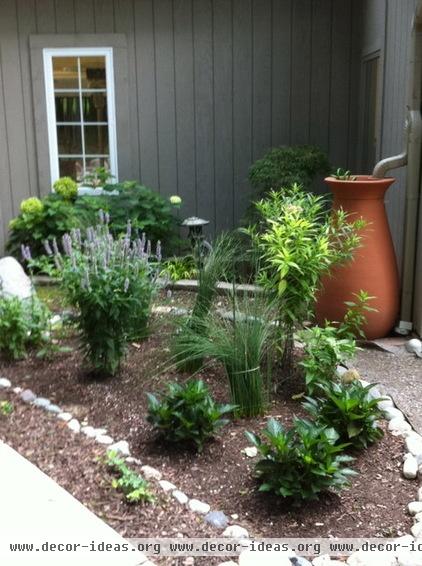
Is this a DIY project? Absolutely. Many home improvement stores carry a range of rain tanks and, as long as you already have gutters and downspouts installed, adding the attachment is not too difficult. You just need a downspout diverter and a screen or filter to keep out debris. When you purchase the tank, instructions are usually included.
If certain peculiarities of your roof or garden prevent you from getting your hands dirty yourself, consider hiring a landscaper with experience in rainwater harvesting systems.
Some things to watch out for: Possible contaminants in your runoff water. Make sure to think about where the rainwater was before it arrived in your tank, and where that water is going to be used. You wouldn’t want to spray your tomatoes with lead-contaminated water, for example.
Cost and Materials
In general. Assuming you’ll be purchasing an aboveground barrel or tank and installing it yourself, the cost can be quite low. It basically comes down to the material of the barrel you select, plus the diverter and filter accessories. Often you will find all the necessary attachments sold in the same place as the barrels, in a kit for an extra $50 or so. Some places will also offer to install everything for you for a low fee.
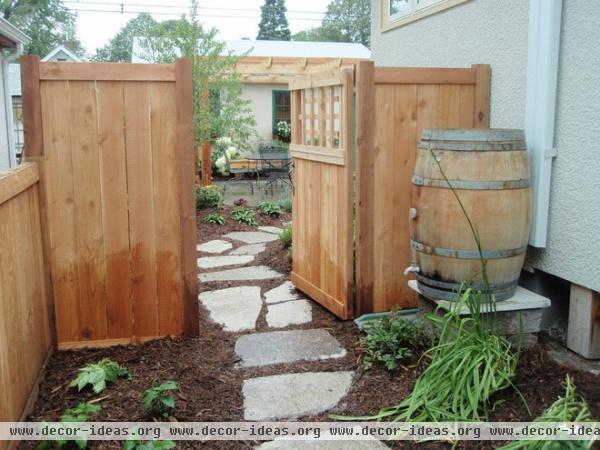
Wood. Wooden barrels are one of the most attractive DIY options, with that rustic look. Watch out for leaks, though, because when the wood dries out, it shrinks a bit, leaving gaps in the barrel. The price of a new wooden barrel can be a few hundred dollars, but often you can get used ones online for much less. Just make sure you know what it was used for and consider any contaminants.
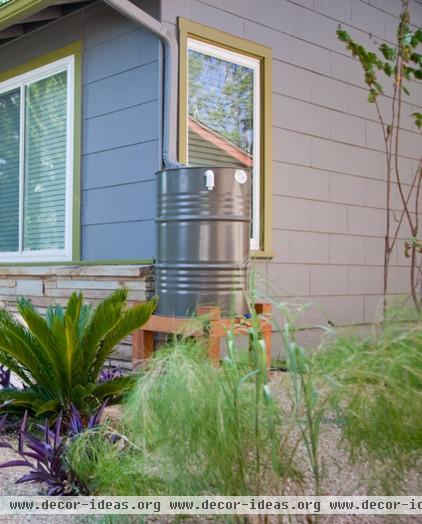
Rain Barrel by Green Water Steel. This is one of the most common materials for tanks, due to the sleek look and low cost. Some steel tanks even have vinyl “bladders” (sacks) inside them, which actually hold the water. They often come in sizes much larger than the one pictured here, and can be more difficult to find at home improvement stores. You may want to search online for “tanks” as opposed to “barrels,” if you’re interested in this material. In general, metal barrels will stand up to heat a bit better than plastic.
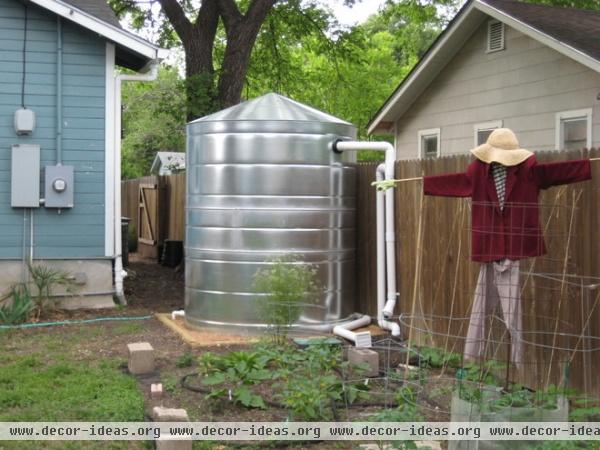
Rainwater Harvesting Systems Galvanized metal. Galvanized and enclosed metal tanks tend to be a bit more expensive and come with a seal that allows the tank to be hooked up to a potable water system. These are usually sold by companies that specialize in rainwater harvesting.

Concrete. Concrete tanks are a durable option that can be a flexible feature in the design of your outdoor spaces, since they can theoretically come in many shapes. Supposedly concrete also has the side effect of balancing out the pH levels of acidic rainwater. The design and execution would be best carried out by professionals.
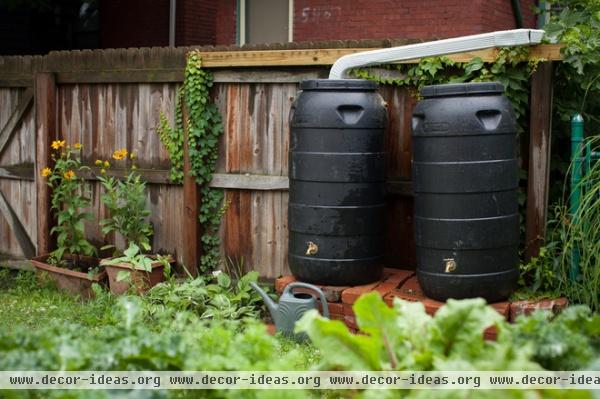
Plastic. The light weight of plastic tanks makes them a popular DIY pick, especially because they come in all kinds of colors and shapes and are available at most home improvement stores for low prices (small ones can be found for under $100). Make sure to stick with the darker ones, so that sunlight can’t reach your water and cause algae blooms. And keep in mind that there are many different kinds and qualities of plastic barrels, so it may serve you well to check consumer reviews first.
There are also fiberglass tanks (not pictured), which are rigid enough to be used underground as well.

How much rainwater do I need to water my garden? Well, that depends a lot on your garden, your climate, and your watering habits. Try this test to evaluate your water needs before buying a rain tank:
Take an empty gallon jug (or any larger container with gallons marked on it), go out to your garden and turn your hose on to the pressure at which you like to water your garden. Time how long it takes to fill up that gallon jug. The number of gallons divided by the number of minutes is the GPM (gallons per minute) flow rate at which you usually water. (Remember to convert seconds into minutes if you use a small container; 30 seconds equally .5 minute.)Now water your garden, as you normally would, and count how many minutes it takes you with the hose going at that same flow rate. Multiply the number of minutes by the GPM you already calculated to find the total number of gallons you use in your garden for one watering session. If you have a sprinkler system but don’t know the flow rate, you can run a similar test and add that to get your total outdoor water use.
You might be shocked at the results. An average American house uses nearly 100 gallons a day just outdoors. Before purchasing the biggest rainwater tank you can find, though, try adjusting your flow rate and doing the test again. Many people don’t realize that they are actually overwatering their gardens simply because they have high water pressure.
If you need help remembering where to stop the handle, try marking it or placing something that blocks you from turning it farther. (You can also consider planting native plants that require less water, and reducing the amount of open lawn.)
Once you know how many gallons it takes to water your garden, you can see how many watering sessions one rain barrel will give you. For example, if I need 10 gallons a day to water my vegetable garden, and I buy a 50-gallon barrel, then a full barrel will water my veggie garden for five days.
Best time to do this project: This project makes for a great DIY spring weekend with family, and you can start to see the fruits of your labor as soon as those April showers hit.
Keep in mind: If you’re at all suspicious about your roofing material, or the material of whatever surface from which you’re collecting the rainwater, consider having it tested. At the very least, research online the possible contaminants that could come from your kind of roof. This becomes even more important when you’re using the tank water to irrigate an edible garden, since any contaminant would then be consumed.
How long your water can sit in your tank is, again, very dependent on where you’re located. Here in Italy the general rule of thumb is one month. If you’re looking for a system to store water all summer long, you may want to consider other types of rainwater systems that include pumps, filtration and treatment for long-term storage.
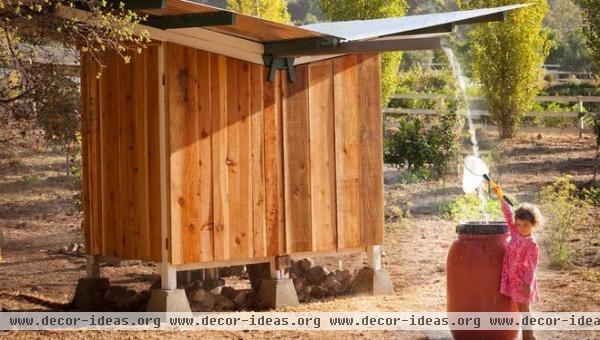
First steps: Depending on where you are located, your annual rainfall will obviously have a big effect on how much water you are able to harvest and use. Some countries, like Australia, have a plethora of online calculators to help you determine what size tank to get based on your roof shape and climate (my favorite Aussie rainwater tool is the Tankulator). In the U.S. you’ll need to search at state or regional levels (like with the EPA’s calculator for the Mid-Atlantic region).
Daily rainfall is all-important too. The U.S. Geological Survey has a supereasy rain calculator that can help you determine how much water falls during a storm. If you know your roof area and inches of rainfall, it tells you how many gallons you can collect. For example, an average roof of 2,700 square feet in a 3-inch downpour storm could collect almost 5,000 gallons of water during that storm. Obviously that would overflow any small DIY barrel.
If there’s no rain, there’s no rain. But if you have a low-water xeriscape landscape, with a 50-gallon barrel and a hose that flows at 10 gallons per minute, that’s five solid minutes of watering a day. One tenth of an inch of rain on a roof that size will give you more than 150 gallons.
Say you do get 1/10 of an inch a day on a 2,700-square-foot roof. And you set up three barrels to collect 150 gallons. That’s 15 minutes of watering at 10 gallons per minute! That’s a lot for some gardens (though not for, say, a golf course).
Or you can head over to Save the Rain, where the interactive website allows you to estimate mean annual rainfall for your exact location. This tool is designed to show the effect of drastic changes in rainfall patterns we can expect to see this century on world food supplies. Once you select your roof from the satellite map, it estimates how much corn, rice, soy and wheat could be grown with the water you could save.
Do you use rainwater in your garden? Let us know in the Comments how you capture, store and use it. Any tips for first-time collectors?
Next: How to use greywater in your landscape
Related Articles Recommended












